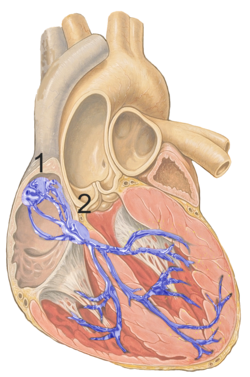Atrioventricular node
| Atrioventricular node | |
|---|---|

Image showing the conduction system of the heart. The AV node is labelled 2.
|
|
| Details | |
| System | Electrical conduction system of the heart |
| Artery | Atrioventricular nodal branch |
| Identifiers | |
| Latin | Nodus atrioventricularis |
| Acronym(s) | AV node |
| TA | A12.1.06.004 |
| FMA | 9478 |
|
Anatomical terminology
[]
|
|
The atrioventricular (AV) node is a part of the electrical conduction system of the heart that coordinates the top of the heart. It electrically connects the right atrium and right ventricle. The AV node lies at the lower back section of the interatrial septum near the opening of the coronary sinus, which conducts the normal electrical impulse from the atria to the ventricles. The AV node is quite compact (~1 x 3 x 5 mm).
The AV node lies at the lower back section of the interatrial septum near the opening of the coronary sinus, which conducts the normal electrical impulse from the atria to the ventricles. The AV node is quite compact (~1 x 3 x 5 mm). It is located at the center of Koch's triangle—a triangle enclosed by the septal leaflet of the tricuspid valve, the coronary sinus, and the membranous part of the interatrial septum.
The blood supply of the AV node is via the Atrioventricular nodal branch. The origin of this artery is most commonly (about 90% of hearts) a branch of the right coronary artery, with the remainder originating from the left circumflex artery. This is associated with the dominance of the coronary artery circulation. In right-dominant individuals the blood supply is from the right coronary artery while in left dominant individuals it originates from the left circumflex artery.
BMP (Bone morphogenetic protein) cell signaling plays a key role in diverse aspects of cardiac differentiation and morphogenesis. (BMPs) are multifunctional signaling molecules critical for the development of AV node. BMP influences AV node development through Alk3 receptor (Activin receptor-like kinase 3). Abnormalities seen in BMP and Alk3 are associated with some cardiovascular diseases like Ebstein’s anomaly and AV conduction disease.
...
Wikipedia
